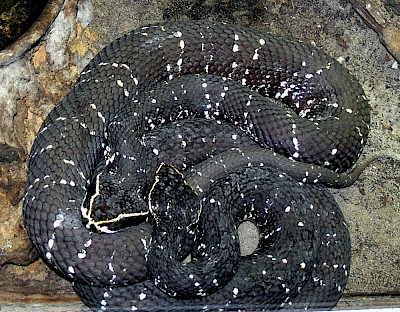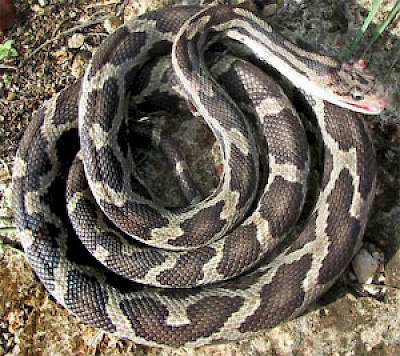Snakes of the Yucatan
Most of us who spend much time in the Yucatan owe a lot to one or two native Yucatecos who counseled us on everything from government bureaucracy to where to find the best deal on doorknobs. And if you're here long enough, someday this happens:
This invaluable friend appears at your door bearing a brightly colored, boldly patterned, horribly mangled little body of a snake, declaring that quick action and a sharp machete have just saved you from a deadly venomous encounter.
In fact if you live here long enough listening to your neighbors' stories about deadly snakes, you'll start getting the impression that every nook and cranny, indeed the whole countryside, is infested with horribly poisonous snakes.
Now let me tell you this: for years I've been tramping around in the Yucatan's woods, along forest trails, through plantations, in old buildings, hacienda gardens, roadsides, etc., and so far I've not for certain seen a single poisonous snake.
I know that they're here, for scientific literature tells me so, and I have a friend near Telchac Pueblo who one day in his orange orchard was bitten by a venomous Cantil and almost lost his leg. Still, my experience has been that poisonous snakes in the Yucatan are much rarer than, say, in Mississippi's piney hills, on Oregon's mountainous slopes, or Kentucky's rural countryside.
Which Venomous Snakes Are Here?
According to distribution descriptions in Jonathan A. Campbell's "Amphibians and Reptiles of Northern Guatemala, the Yucatán, and Belize," here are the dangerously venomous snakes to be found in the Yucatan Peninsula:
- Variable Coral Snake, Micrurus diastema; throughout (pictured in banner)
- Neotropical Rattlesnake, Crotalus durissus; throughout but spotty (first picture at right)
- Cantil, Agkistrdon bilineatus; northern Yucatan (second picture at right)
- Barba Amarilla, Bothrops asper; throughout except the northwest (third picture at right)
- Jumping Pitviper, Atropoides nummifer; southern Yucatan
This means that if your Yucatan base is near Mérida or along the northwestern coast, you only have three venomous species to worry about. You are too far west for the Barba Amarilla (also known as the Fer-du-lance), and too far north for the Jumping Pitviper. For you there's the coral snake, the rattlesnake and the Cantil. The Cantil is closely related to the Northern Water Moccasin or Cottonmouth.
Habits of Snakes
Both coral snakes and Cantils hunt mainly at night, and rattlesnakes are of a very spotty occurrence. Therefore, if you take normal precautions, such as watching where you put your hands and feet when you're in snake country, snakes are just not a big worry in places most of us go to. That is not to say that you needn't be careful in gardens, where there's thick underbrush, in trashy areas or where piles of leaves or other plant material are lying on the ground.
Getting to Know Your Snakes
If you are interested, you might want to consier doing a Google Image search on the venomous species from the list above that are found in your area, study their pictures, and become acquainted with each species' distinctive features.
The five species in the above list fall into two main groups: the coral snakes and the pit vipers. The bottom four species on the list are all pit vipers.
Variable Coral Snakes are known by these features:
- red, yellow and black rings encircle their bodies in the sequence of black-yellow-red-yellow-black
- a black forehead
- the head is about the same width as the neck
How To Recognize the Region's Venomous Snake
Every pit viper has a conspicuous pit, or hole, in its face between each eye and the nostril in front of it. The pits contain heat-sensing organs enabling the snake to locate warm-blooded prey in total darkness. (And you thought they were called pit vipers because they lived in pits, didn't you?)
The vipers and rattlesnake are responsible for most snakebites. At one time, bite fatality was about nine percent, but, due to the development of antivenom, that number has dropped to almost zero. It is important to seek medical treatment right away as the necrotic venom causes tissue necrosis which you can google later for nightmare fuel.
In the Yucatan, any native snake that is not banded like the mostly red-and-black coral snake (banner image), and does not have a pit between its eye and the nostril, is not dangerously venomous.
Mildly Venomous Snakes
Several other snake species are mildly venomous. If they bite you, you may suffer some inflammation and soreness for a few days but that'll pass and leave no lasting effects. Brown Vine Snakes, which more than one campesino has grabbed thinking they were dangling brown vines, are that kind of snake.
Friendly and Harmless Lookalike Snakes
An aggravating feature of dealing with venomous snakes in the Yucatan is that several perfectly harmless, gentle species do a good job mimicking a venomous species. That's especially the case with coral snakes. The Ringed and Short-faced Snail-eater (fifth picture), Long-tailed False Coral, Red Coffee Snake (fourth picture at right), and the Tropical Milksnake all look somewhat or very much like venomous coral snakes. Some of them are quite common, and are likely to be seen during the day. The vast majority of snakes I've seen mangled because they were identified as coral snakes have been harmless, wonderful little Tropical Milksnakes, who like to curl up in flowerpots on patios, and little Red Coffee Snakes, who have a passion for trashy areas, and who, if you nudge them, are likely to fall over in a faint, not bite.
Snakes, In General, Are Nice
Snakes play an important part in maintaining the balance of species in the ecosystem, especially with regard to controlling rodent populations. Even more important, snakes are beautiful and worthy creatures in their own right. Not every snake you find should be killed, therefore, and it would do the Yucatan environment a world of good if we all learned how to tell the venomous apart from the harmless.
Editor's Note: We have to concur with Jim Conrad, the Backyard Nature guy... we have lived here for many years and the only snakes we have seen have been dead on the highway.
If you enjoyed this article, we encourage you to read more about the nature around you in Jim's wonderful website, www.backyardnature.net. and look for more articles about the Yucatan natural world here soon!
















Comments
Working Gringos 11 years ago
Thank you, Maria. We agree with you... snakes are not bad! If you need help identifying one, we suggest you check out this website and contact Jim, the author: http://www.backyardnature.net/yucatan/
Reply
Maria 11 years ago
Quite interesting information you show about snakes and emails with the instinctive reaction to kill them ("Jhom" said on October 10th, 2011). Since I am from the "new generation", as jhom said, that see first before killing, I could say snakes are not cold killers that see humans and jump to you with the intention of killing you. Quite opposite, we are too big to be eaten for them (referring to Mexican species), so they prefer to leave us instead of biting us. I suggest to take a photo and try to identify with a specialist (in a great majority of cases, they are insectivores or eat small mammals like mice, so they do a favor to human populations). The animals can live in your garden and be safe. Just have your yard all clean around your house (no cans or rubbish in corners where they could hide). If you have bushes at the end of your garden, they could be there around and eating mice and cockroaches and everybody is happy. My brother lives in Veracruz City and there are 2 species of snakes. They eat insects and maybe small lizards and no problem at all. I am trying to identify a species. If someone could help me with this, please let me know :-)
Reply
Working Gringos 11 years ago
Jack, you might consider getting some EMDR treatment (Google it!) for that snake phobia... and then you can look at the photos!
Reply
jack oswald 11 years ago
Thank all for information on snakes. I have had an intense phobia re:snakes. I cannot even look at a photo, picture or drawing of one!! But all life is a beautiful entity. Even rocks have a life , very long in geologic time. Thank you!
Reply
rick b 12 years ago
I live in Puerto Morelos south of Cancun and have been here for almost 17 years. I have seen many snakes and at times often see several in a week. For the most part, they are tree climbing ribbon snakes, small brown snakes and boas. I have, however, seen several coral snakes and various snakes which the locals claim to be venomous. Also have seen a couple of beautiful green vine snakes, and have also seen snakes on the beach going into the water (my house is about 300 meters from the beach).
Reply
Lucie Anne 12 years ago
Location of these hopefully 'false corals' is Valladolid, near the center. I hope someone can reassure me , maybe with a strong positive id for the red coffee snake, seems to be my best bet.
Reply
Lucie Anne 12 years ago
From time to time I spot in my patio coral colored snakes, smallish, pencil size. Black mask to yellow above that with small bulbus yellow side protrusions making the head look triangularish, then below the yellow a black ring around neck, tiny hint of yellow below and coral all the way down to end, no more rings. Quite pretty really but too close to a real coral? His friend appeared shortly and was a little longer (12inches and 15 inches maybe) and a bit fatter. both escaped the bucket I had them in to show to the vet. I have a very shady garden, well water irrigated, mulched - i know, I know- but I want to know if they are dangerous. I have nice photos
Reply
Stephanie 12 years ago
Have lived in a small port town west of Progresso for 1 1/2 years now and the first snake I have seen was just about a half hour ago. Needed to check on what type of snakes are down here because I believe it got one of our beach dogs nose. Don't think it was venomous though. Watching our girl to make sure she is OK. Chased it out of the yard, don't think it will want to come back anytime soon.
Don't cancel plans for vacations it is great down here.
Reply
janet 12 years ago
I'm one of those who loves snakes, they are so beautiful, elegant, simple and direct. When I live down there full time I dream of offering a 'catch and release' service for snakes. It's spiders that give me the shivers, but regardless, I'd never dream of killing something just because it exists.
Reply
Jennifer 12 years ago
Thank-you for your reassurance... I have to say the thought of even one little harmless snake in the house is enough to make my head spin! But I do realize my fear may be over exaggerated, and I may chance it! Thanks again!
Reply
Working Gringos 12 years ago
Ladies, Working Gringa here... have lived in Merida for ten years. In that WHOLE time, I saw one tiny little harmless snake in my house and two on the road (while driving). Never saw one walking... which is NOT a claim I can make for California. Merida is not the jungle... you will be perfectly safe, with or without your husband. Seriously.
Reply
« Back (10 to 21 comments)Next »